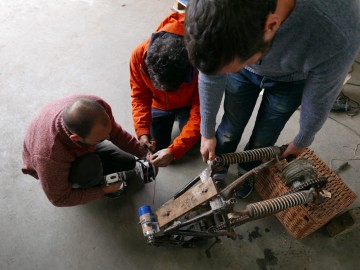Design practice always happens under a particular set of rules, commonly known as constraints. These constraints may be straightforward and indisputable, such as the force of gravity, the tensile strength of a structural beam, or a financial budget. They provide tangible criteria to be adhered to or challenged.
Constraints, however, also exist in more abstract, systemic or hidden forms, such as legislation, legacy infrastructures or even belief systems. The constraint of progress dogma, for example, blinds future-shapers—scientists, technologists, politicians, designers—from the potentially negative implications of their proposals. National systems of infrastructure, such as energy grids or roads, have become so normalised that they constrain designers to simply designing for or within the dominant paradigm: rather than providing an opportunity for radical solutions, emergent technologies are simply added to the existing system.
Such meta-constraints are often overlooked by designers as they focus on the more practical, material, human-scale and (seemingly) apolitical constraints familiar to their practice. The pervasive nature of these grander constraints results in a narrower range of technological possibilities than we might otherwise experience. They keep us to a limited path or trajectory, and in some cases condemn us to repeating the same mistakes over and over again. Rather than acting directly, their path of influence is oblique.

Reconstrained Design is an approach originally developed at the Madeira Interactive Technologies Institute in Portugal. With a focus on sustainability, the group develops approaches that facilitate the removal of oblique constraints. For example, we are challenging the dominance of the grid system through developing functional prototypes that operate outside of its control. Solutions include gravity batteries to provide night-time storage from solar or wind power using the natural phenomenon of gravity in vertiginous regions. The uniqueness of this battery is its ability to be built, installed and maintained by local communities using local materials and techniques and to not rely on any external help or funding. It uses basic physics principles to provide an easily achievable and efficient way to store energy without conventional battery systems. By thinking about what lies beyond the wall—local contexts, landscapes, materials, skills, culture—it becomes possible to develop bespoke solutions which question existing power relations and envision tangible, preferable, shared futures.

Reconstrained Design emphasises critical, situated and future-focused design, especially but not exclusively in the domain of renewable energy. Working at the leading edge of international research, the group embodies ‘third culture’ values of transparency and legibility, making ethereal concepts such as energy consumption, sourcing and storage tangible to people through direct experience.
It can be explained by the following tenets:
| Constrained | Reconstrained |
|---|---|
| ancient resources | real time |
| device | thing |
| object | system |
| abstract | tangible |
| generic | bespoke |
| spectator | participant |
| throwaway | fix |
| dominate nature | collaborate with nature |
| desires | needs (or satisfying need in desirable ways) |
| conceal | reveal |
| universal | local |
| cynicism | hope |
| short-term thinking | long-term thinking |
| centre-periphery | periphery-centre |